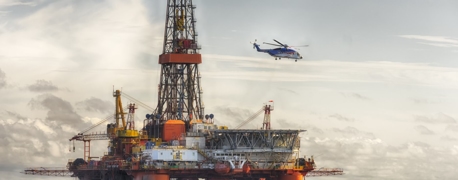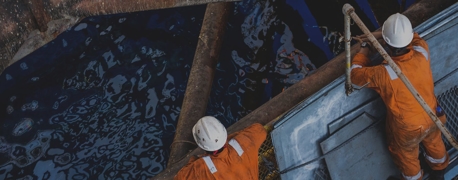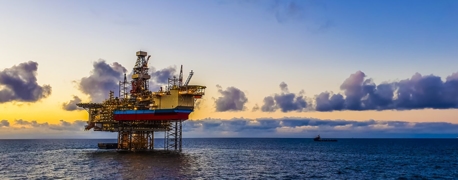5 Most Interesting Places on an Oil Rig

There’s something objectively impressive about offshore drilling rigs. They’re taller than most skyscrapers, stretching from the depths of the sea to hundreds of feet in the air. They’re essentially mini-cities with dozens of facilities and crew serving diverse purposes. There are 125 oil rigs in the Gulf of Mexico employing 10,000 to 12,500 workers total. If you count indirect employment, the offshore industry employs over 62,000 people, or 3.3% of all the jobs in Louisiana.
By their nature, these cities-at-sea hold a lot of mystery. How do they operate? What’s it like to live and work hundreds of feet above open water? What kind of dangers do they hold for the uninitiated?
Today’s article is about describing those very dangers and where they can be found.
#1: The Kelly Spinner / Cathead / Rotating Wellhead
These names all describe different components of the spinning wellhead that the entire offshore drill is built around. This is the part of the rig that requires the most attention, skill, and physical action in order to operate it safely. Kelly rigs are less common on modern offshore rigs—the newest rigs use top drive systems—but you’ll still see Kelly rotating systems on old offshore rigs and land rigs.
The men in the video above are clearly experienced and practiced at handling a Kelly rig, but it should be obvious how dangerous a rig like this is for workers who are unprepared, inadequately trained, or even just fatigued. Workers have to navigate around spinning parts, taut chains, and high-pressure fluids as they manage the machinery—any of which could cause them permanent harm in the wrong circumstances.
Our firm has worked directly with workers whose arms, shoulders, or backs were catastrophically injured from accidents involving a rotating wellhead. In fact, a 2017 study of offshore rig accidents found that 32% of fatalities were from falling debris or getting crushed by machinery.
#2: The “Wet Porch”
For a drilling rig to work, designers had to build a way for the hull to open up so the drilling equipment could drive straight down from the drilling rig. This became known as the “wet porch,” or the moon pool. The moon pool is an opening in the hull or vessel that allows equipment to pass through the vessel into the water. However, the moon pool has been adopted by research vessels because it allows researchers access to the water without stepping onto open decks or suffering exposure to unsafe conditions.
However, the moon pool is also a massive hole over open water. The hazards inherent in that feature should be clear: falling into frigid, open water where even a few seconds of exposure can cause harm, or into a gathering of marine life (which is a factor for offshore drills). Moon pool accidents aren’t common, but there’s something objectively threatening about having an opening in your vessel over hundreds of feet of water.
#3: Open Decks
A lot of the work done abroad an offshore rig takes place on open decks, where all that’s keeping a worker from a hundred-foot fall into the water is some railing. Railing is typically sufficient for factories or construction sites, but the hazards inherent to offshore drilling means railing may not be enough. For instance, liquid hydrocarbons can turn any floor into a slick and deadly surface. Combine that with an open-air deck and old railing, and you have the recipe for a deadly fall. In fact, a high percentage of drilling rig accidents or deaths offshore involve falling into the water or from an upper level to a lower level.
#4: Shale Shaker
Drill fluid serves two purposes: it carries solids up from the well and keeps the drill cool. However, because drill fluid is expensive, it has to be reused, which necessitates removing all the solids from it before circulating it back into the drill. The shale shaker is responsible for clearing out all the solids from the drill fluid to ensure safe and efficient operation of the entire rig.
At the same time, its function makes it a serious potential hazard. The high-powered shaking and vibration of drilling fluid and deep-sea solids increase the risk of combustion. Combustible gases in the shale shaker can create fires or explosions—the effects of which are compounded by the tight spaces on an offshore drilling rig.
#5: Storage Tanks
If there’s one thing you can expect to find on a drilling rig at sea, it’s storage tanks. A lot of storage tanks. Storage tanks for product, for fluids necessary for the function of the drill, or for byproducts created by drilling. Here’s the hazard created by those storage tanks: over time, vapors and toxic chemicals will accumulate, requiring workers to clean them out periodically. However, the job of cleaning out storage tanks is almost as dangerous as handling the rotating wellhead: workers risk asphyxiation, toxic exposure, or even explosions due to accumulated vapors and chemicals in the tanks.
Our firm has investigated industrial accidents involving storage tanks time and time again. Ultimately, companies need to ensure safe policies and procedures are in place for cleaning out storage tanks. It only takes seconds for a worker to fall unconscious and asphyxiate inside an improperly ventilated tank.
BONUS: The Helipad
This one is more symbolic than the others, but there are helipad-related deaths on offshore rigs. The fact is, 1 in 4 offshore drilling rig worker fatalities don’t take place on the rig, but simply on the way to and from the vessel. Highway fatalities, helicopter accidents, and transfer basket accidents account for an enormous percentage of rig workers injuries and deaths—despite being the easiest to prevent!
Companies owe it to workers to ensure that travel to and from the rig is safe and convenient—especially if the helipad or final transfer is in a remote area. Implementing shuttles would not only save money, but lower the chance of exhausted workers getting in collisions to and from the rig.
All of the hazards we’ve mentioned today are routine dangers faced by offshore rig workers every day. However, that doesn’t mean the company can accept hazards for what they are. In the end, companies ought to be working around the clock to ensure rig work gets safer every year. It’s the least they can do for the employees who work around the clock under truly incredible circumstances.


